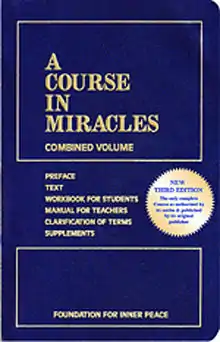A Course in Miracles
A Course in Miracles (also referred to as ACIM or the Course) is a 1976 book by Helen Schucman. The underlying premise is that the greatest "miracle" is the act of simply gaining a full "awareness of love's presence" in one's own life.[1] Schucman claimed that the book had been dictated to her, word for word, via "inner dictation" from Christ.[2][3] The book is considered to have borrowed from various New Age movement literature.[4][5]
 A Course in Miracles, Combined Volume, Third Edition as published by the Foundation for Inner Peace. | |
| Editor | Helen Schucman, Bill Thetford, Kenneth Wapnick |
|---|---|
| Author | There is no author attributed to ACIM, although it was "scribed" by Helen Schucman |
| Country | United States |
| Subject | Transformation |
| Publisher | 1976 (New York: Viking: The Foundation for Inner Peace) 2007 (The Foundation for Inner Peace, 3rd ed.) |
| Media type | Print (hardback and paperback) |
| Pages | 1333 |
| ISBN | 978-1-883360-24-5 |
| OCLC | 190860865 |
| Part of a series on the |
| Paranormal |
|---|
| Part of a series of articles on |
| New Thought |
|---|
|
The Course consists of three sections: the "Text", "Workbook for Students", and "Manual for Teachers". Written from 1965 to 1972, some distribution occurred via photocopies before a hardcover edition was published in 1976 by the Foundation for Inner Peace.[6] The copyright and trademarks, which had been held by two foundations, were revoked in 2004[6] after lengthy litigation, because the earliest versions had been circulated without a copyright notice.[7][8]
Throughout the 1980s annual sales of the book steadily increased each year; however the largest growth in sales occurred in 1992 after Marianne Williamson discussed the book on The Oprah Winfrey Show,[6] with more than two million volumes sold.[6] The book has been called everything from "New Age psychobabble"[9] to "a Satanic seduction"[6] to "The New Age Bible".[10] According to Olav Hammer, the psychiatrist and bestselling author Gerald G. Jampolsky has been among the most effective promoters of the Course. His first book, Love is Letting go of Fear, which is based on the principles of the Course, was published in 1979 and after being endorsed on Johnny Carson's show went on to sell over three million copies by 1990.[11]
Origins
A Course in Miracles was written as a collaborative venture between Schucman and William ("Bill") Thetford. In 1958, Schucman began her professional career at Columbia-Presbyterian Medical Center in New York City as Thetford's research associate.[12][13] In 1965, at a time when their weekly office meetings had become so contentious that they both dreaded them, Thetford suggested to Schucman that "[t]here must be another way".[14] Schucman believed that this interaction acted as a stimulus, triggering a series of inner experiences that were understood by her as visions, dreams, and heightened imagery, along with an "inner voice" which she identified as Jesus. She said that on October 21, 1965, an "inner voice" told her: "This is a Course in Miracles, please take notes." Schucman said that the writing made her very uncomfortable, though it never seriously occurred to her to stop.[15] The next day, she explained the events of her "note taking" to Thetford. To her surprise, Thetford encouraged her to continue the process. He also offered to assist her in typing out her notes as she read them to him. The transcription the next day repeated itself regularly for many years. In 1972, the dictation of the three main sections of the Course was completed, with some additional minor dictation coming after that point.[16]

Reception
Since it went on sale in 1976, the text has been translated into 22 languages.[17] The book is distributed globally, spawning a range of organized groups.[18]
Wapnick said that "if the Bible were considered literally true, then (from a biblical literalist's viewpoint) the Course would have to be viewed as demonically inspired".[19] Though a friend of Schucman, Thetford, and Wapnick, Catholic priest Benedict Groeschel criticized ACIM and related organizations. Finding some elements of ACIM to be "severe and potentially dangerous distortions of Christian theology", he wrote that it is "a good example of a false revelation"[20] and that it has "become a spiritual menace to many".[21] The evangelical editor Elliot Miller says that Christian terminology employed in ACIM is "thoroughly redefined" to resemble New Age teachings. Other Christian critics say that ACIM is "intensely anti-biblical" and incompatible with Christianity, blurring the distinction between creator and created and forcefully supporting the occult and New Age worldview.[4]
Olav Hammer locates A Course in Miracles in the tradition of channeled works from those of Madam Blavatsky through to the works of Rudolf Steiner and notes the close parallels between Christian Science and the teachings of the Course.[22] Alternatively it can be seen more broadly as part of the tradition of mystical literature described in William James' The Varieties of Religious Experience and Aldous Huxley's The Perennial Philosophy. In "'Knowledge is Truth': A Course in Miracles as Neo-Gnostic Scripture" in Gnosis: Journal of Gnostic Studies, Simon J. Joseph outlines the relationship between the Course and Gnostic thinking.[23] Daren Kemp also considers ACIM to be neo-Gnostic.[24]
The Skeptic's Dictionary describes ACIM as "a minor industry" that is overly commercialized and characterizes it as "Christianity improved". Robert T. Carroll wrote that the teachings are not original but are culled from "various sources, east and west". He adds that it has gained increased popularity as New Age spirituality writer Marianne Williamson promoted a variant.[5]
Associated works
Two works have been described as extensions of A Course in Miracles, Gary Renard's 2003 The Disappearance of the Universe and Marianne Williamson's A Return to Love, published in 1992.[6][25][26][27] The Disappearance of the Universe, published in 2003 by Fearless Books, was republished by Hay House in 2004.[28] Publishers Weekly reported that Renard's examination of A Course in Miracles influenced his book.[29]
See also
References
- A Course in Miracles. Foundation for Inner Peace. Introduction, Page 1. Retrieved December 29, 2017.
- "ACIM: About the Scribes". acim.org. Foundation for Inner Peace. Retrieved December 29, 2017.
- Foundation for Inner Peace (1992). A Course in Miracles: Combined Volume (2nd ed.). Glen Ellen, Calif.: The Foundation. pp. vii–viii. ISBN 0-9606388-9-X. Retrieved December 29, 2017.
- Newport, John P. (1998). The New Age movement and the biblical worldview: conflict and dialogue. Wm. B. Eerdmans Publishing. p. 176. ISBN 978-0-8028-4430-9.
a course in miracles christian criticism.
- Carroll, Robert Todd (2003). The skeptic's dictionary: a collection of strange beliefs, amusing deceptions, and dangerous delusions. John Wiley and Sons. ISBN 978-0-471-27242-7.
- Miller, D. Patrick (November 23, 2011). Understanding A Course in Miracles: The History, Message, and Legacy of a Spiritual Path for Today. Berkeley, CA: Celestial Arts. ISBN 9780307807793. Retrieved December 29, 2017.
- Beverley, James (May 19, 2009). Nelson's Illustrated Guide to Religions: A Comprehensive Introduction to the Religions of the World. Thomas Nelson Inc. pp. 397–. ISBN 9781418577469. Retrieved December 29, 2017.
- "Recipient's Common Interest in Subject of Work Does Not Limit Publication". Patent, Trademark & Copyright Journal. Bureau of National Affairs (BNA). 67 (1645): 16–17. 2003.
- Boa, Kenneth; Bowman, Robert M. (1997). An Unchanging Faith in a Changing World: Understanding and Responding to Critical Issues that Christians Face Today. Oliver Nelson. ISBN 9780785273523. Retrieved September 28, 2014.
- "The Imminent Heaven: Spiritual Post-Metaphysics and Ethics in a Postmodern Era". Archived from the original on June 21, 2016. Retrieved September 28, 2014.
- Hammer, O, 2004, "Claiming Knowledge : Strategies of Epistemology from Theosophy to the New Age", Studies in the History of Religions 90, Brill, Leiden, Boston p. 451.
- Helen Schucman's Career
- "A Course in Miracles Book ACIM Lessons Online and Text". ACIM Portal. Retrieved December 25, 2017.
- Helen Schucman: Autobiography, in "Origins of A Course in Miracles" 3:27–28. Foundation for Inner Peace Archives, Tiburon, CA).
- Skutch, Robert. Journey Without Distance: The Story Behind A Course in Miracles. Ten Speed Press, Berkeley, CA, 1984, p. 58.
- Final Dictation of The Song of Prayer
- "ACIM Translations". Foundation for Inner Peace. Retrieved September 28, 2009.
- Bradby, Ruth, "A course in miracles in Ireland". 147 – 162 in Olivia Cosgrove et al. (eds), Ireland's New Religious Movements. Cambridge Scholars, 2011.
- Dean C. Halverson, "Seeing Yourself as Sinless", SCP Journal 7, no. 1 (1987): 23.
- Groeschel, Benedict J., A Still Small Voice (San Francisco: Ignatius Press, 1993) p. 80
- Groeschel, Benedict J., A Still Small Voice (San Francisco: Ignatius Press, 1993) p. 82.
- Hammer, O, "Claiming Knowledge : Strategies of Epistemology from Theosophy to the New Age", Studies in the History of Religions 90, Brill, Leiden, Boston, 2004.
- Joseph, Simon J. "
'Knowledge is Truth
- A Course in Miracles as Neo-Gnostic Scripture" in Gnosis: Journal of Gnostic Studies, Volume 1, Issue 2, March 22, 2017.
- Kemp, Daren (March 2004). Clarke, Peter (ed.). Encyclopedia of New Religious Movements. Routledge. p. 1. ISBN 978-1-134-49970-0.
- Butler-Bowdon, Tom.50 Spiritual Classics: Timeless Wisdom From 50 Great Books of Inner Discovery, Enlightenment and Purpose. Nicholas Brealey Publishing, 2010. p. 223.
- Butler-Bowdon, Tom. The Literature of Possibility. Nicholas Brealey Publishing, 2013. p. 223.
- Coburn, Lorri. Breaking Free: How Forgiveness and A Course in Miracles Can Set You Free. Balboa Press, 2011. p. 193.
- Wilson, Brandy (July 29, 2006). "Community of Faith: NEWS FROM HOUSES OF WORSHIP: 'Disappearance of Universe' author to host workshop". The Atlanta Journal-Constitution. Archived from the original on August 8, 2017. Retrieved August 8, 2017.
- Garrett, Lynn (March 7, 2005). "'Disappearance' Appears Big Time". Publishers Weekly. Archived from the original on August 8, 2017. Retrieved August 8, 2017.
External links
- Editions in public domain:
- Urtext Edition – Published by Miracles in Action Press
- Sparkly Edition – Published by Diamond Clear Vision
 Quotations related to A Course in Miracles at Wikiquote
Quotations related to A Course in Miracles at Wikiquote Works related to A Course in Miracles at Wikisource
Works related to A Course in Miracles at Wikisource
| Wikisource has original text related to this article: |